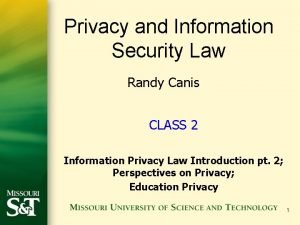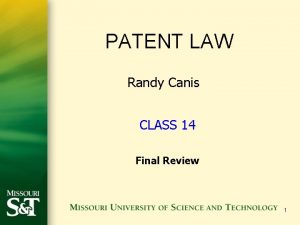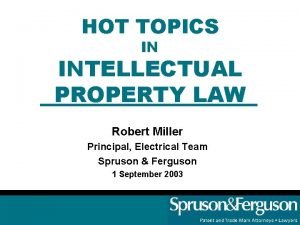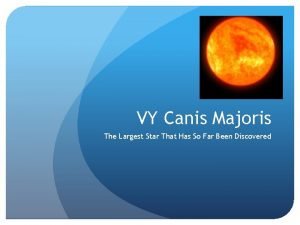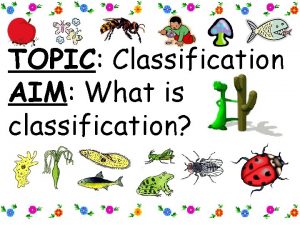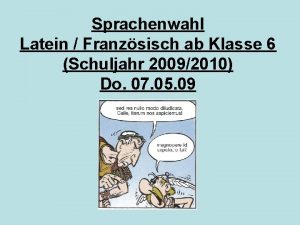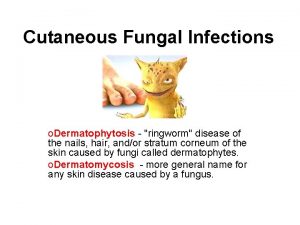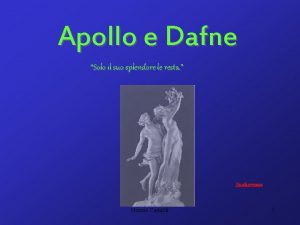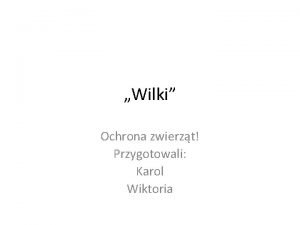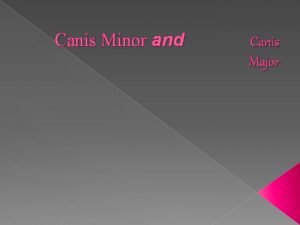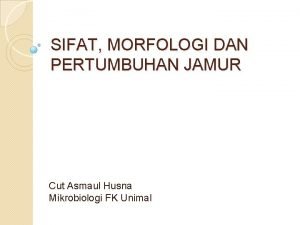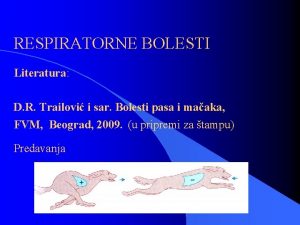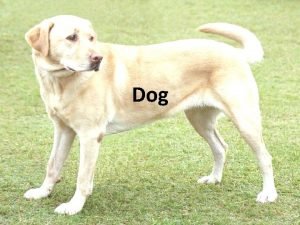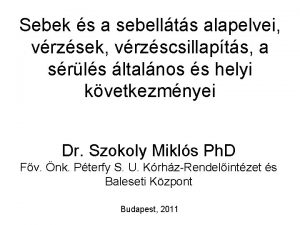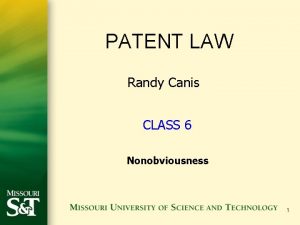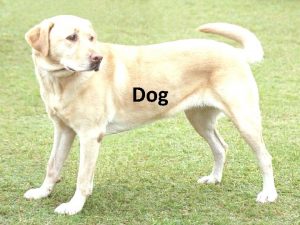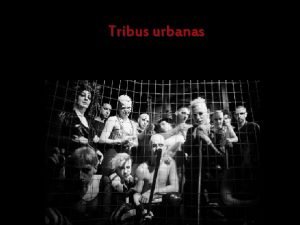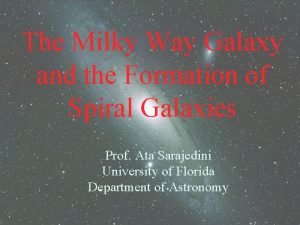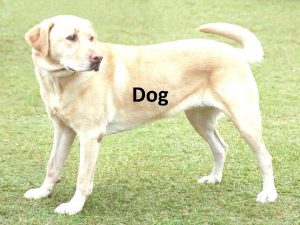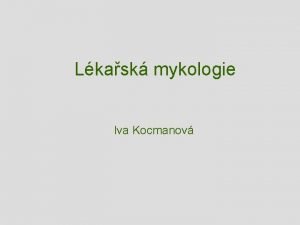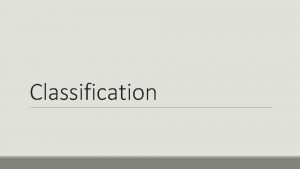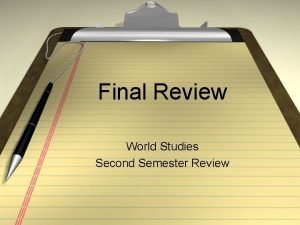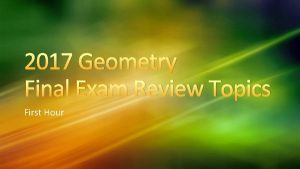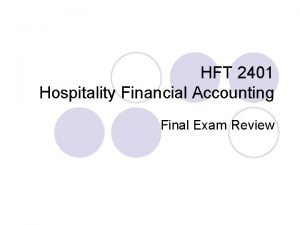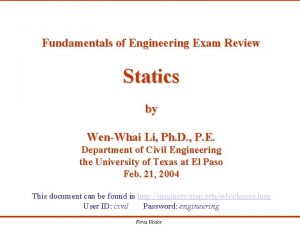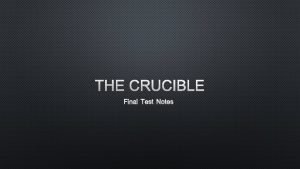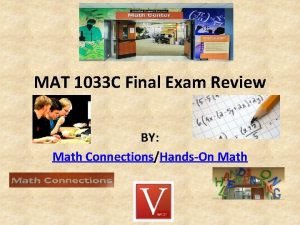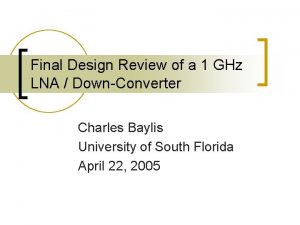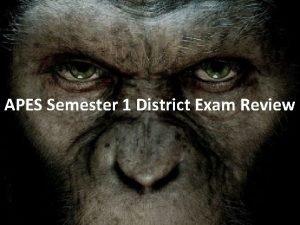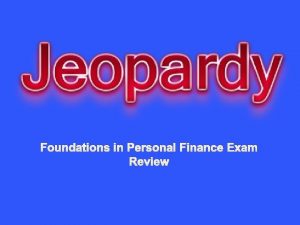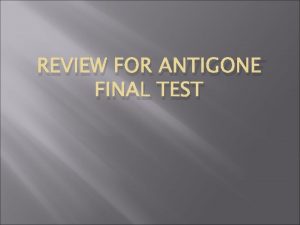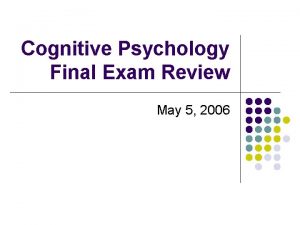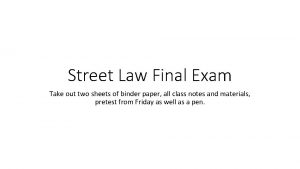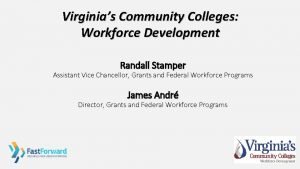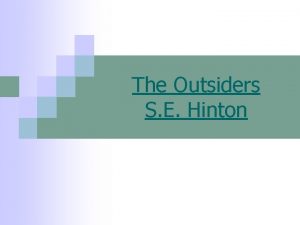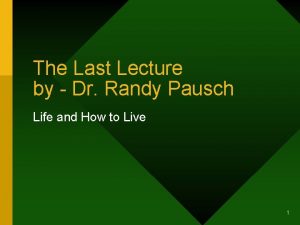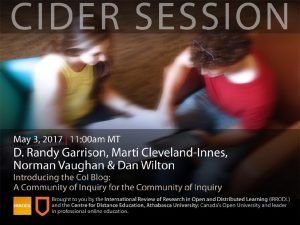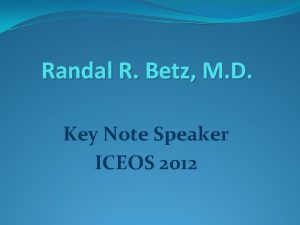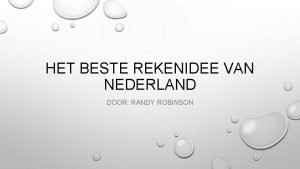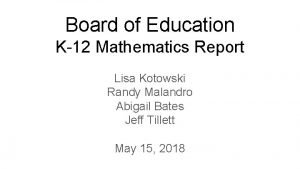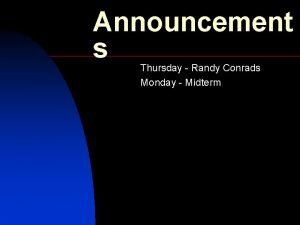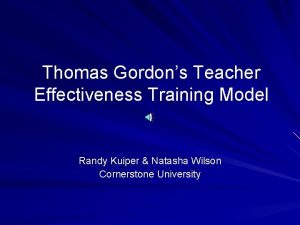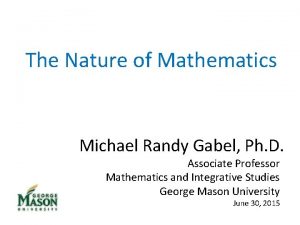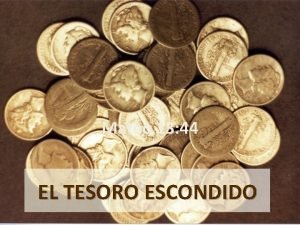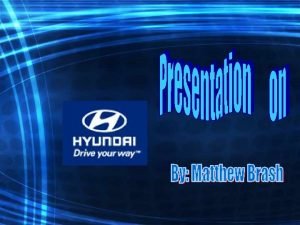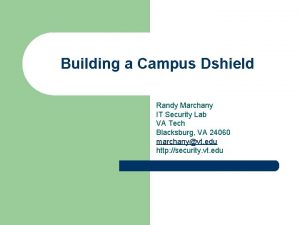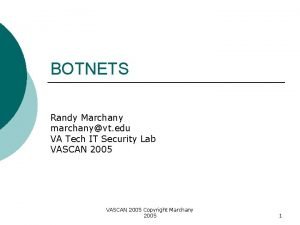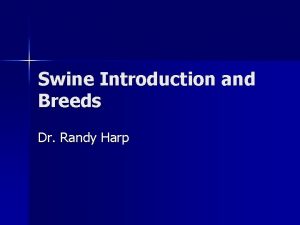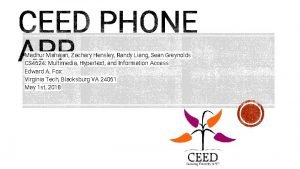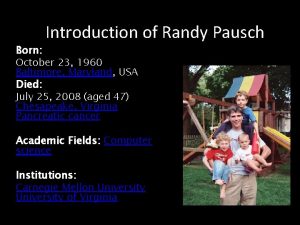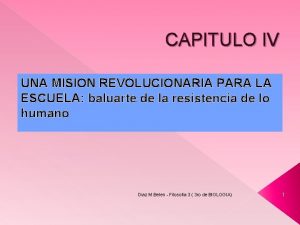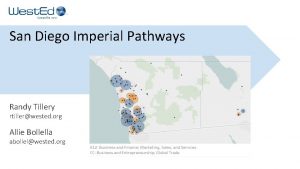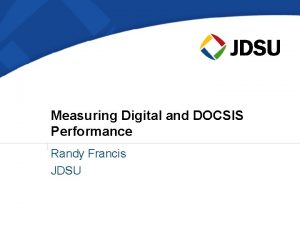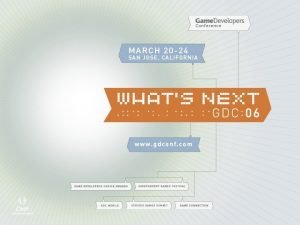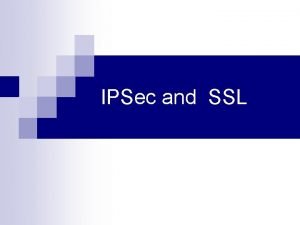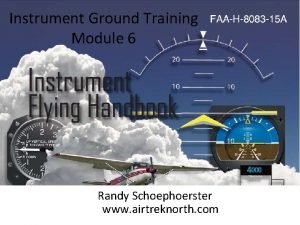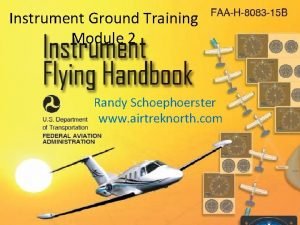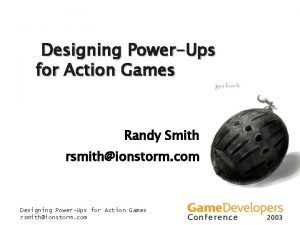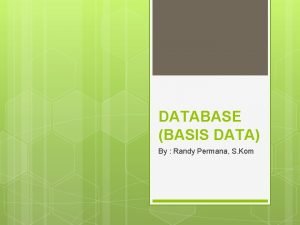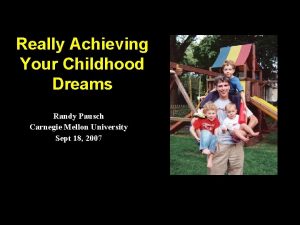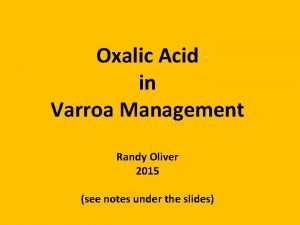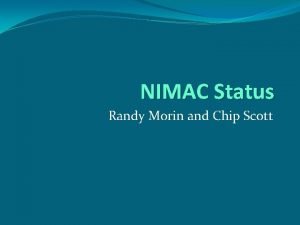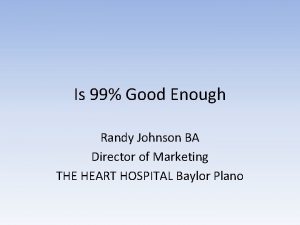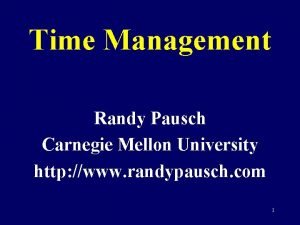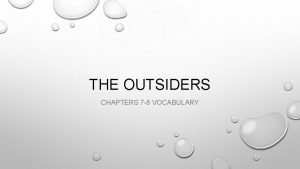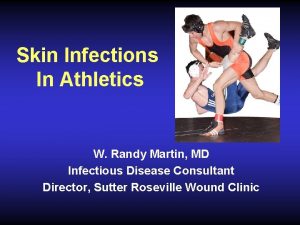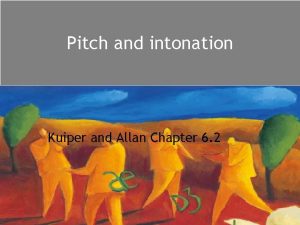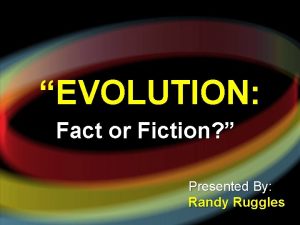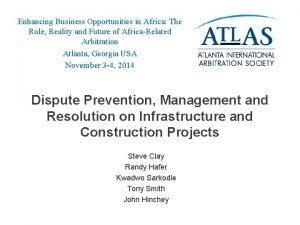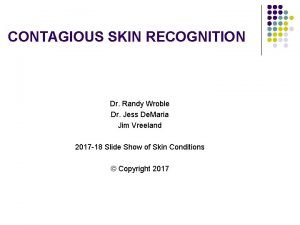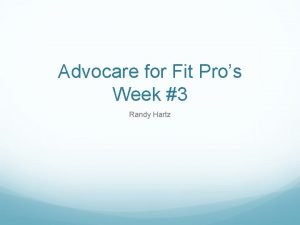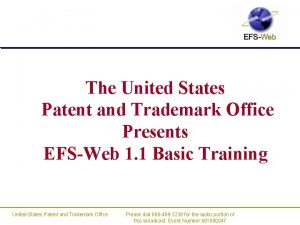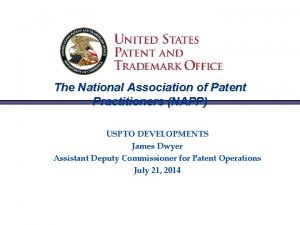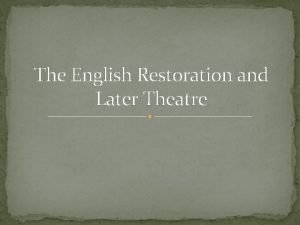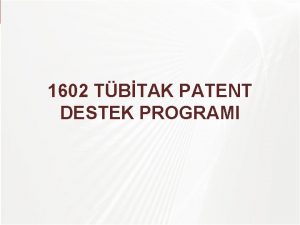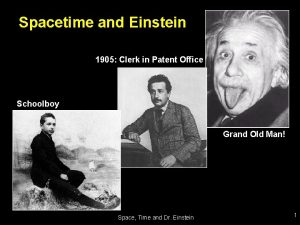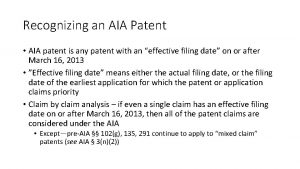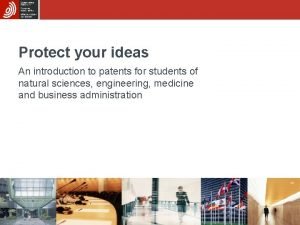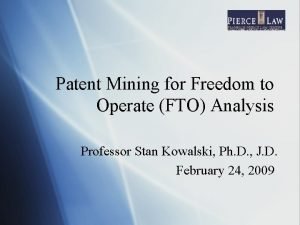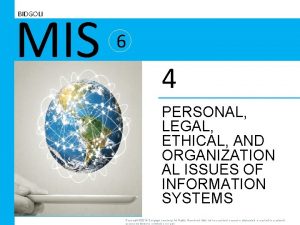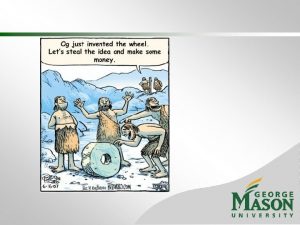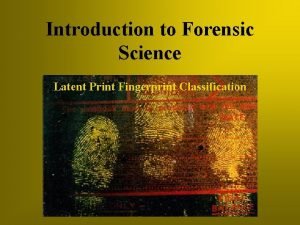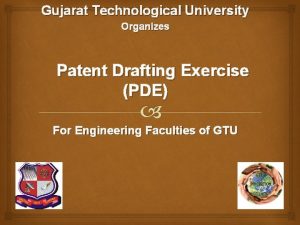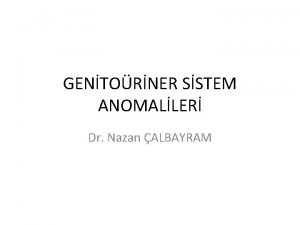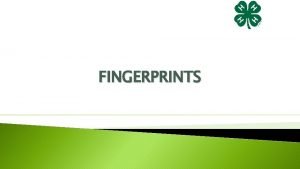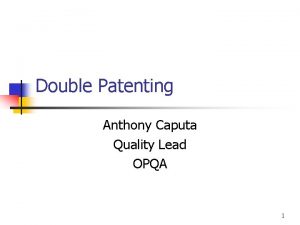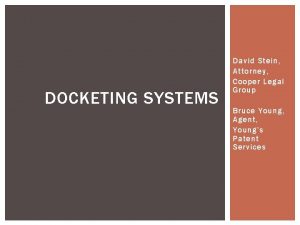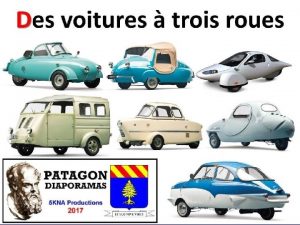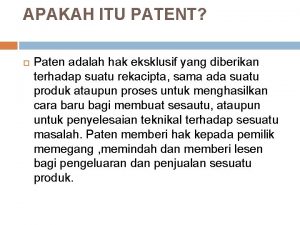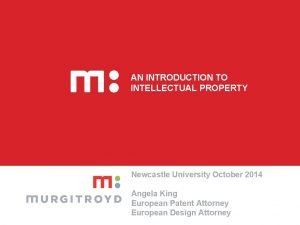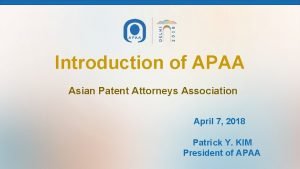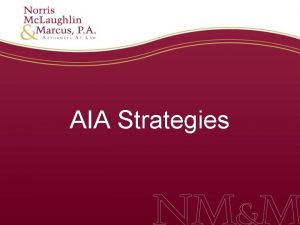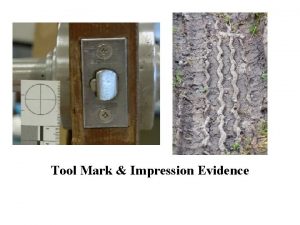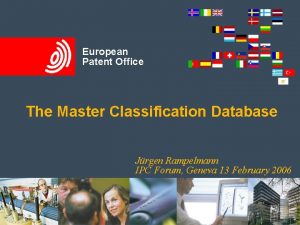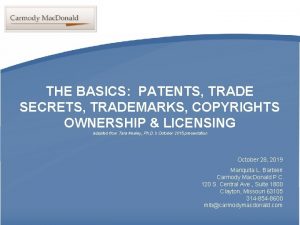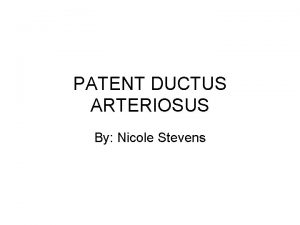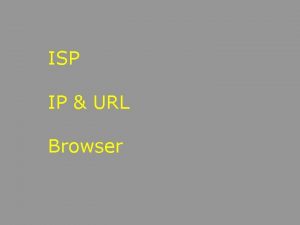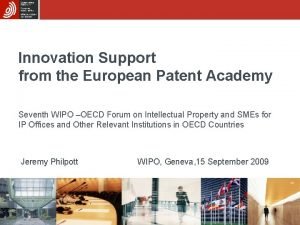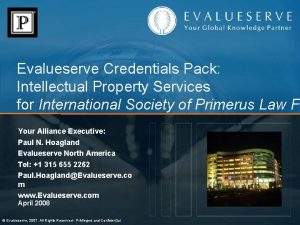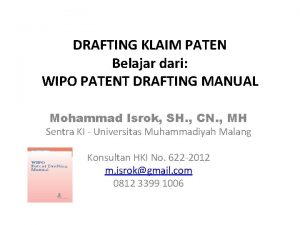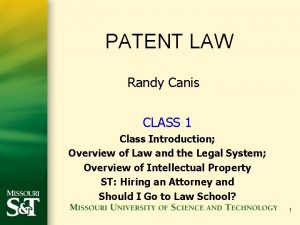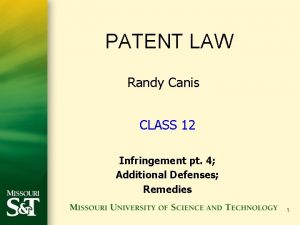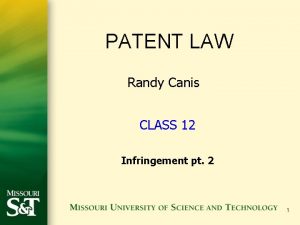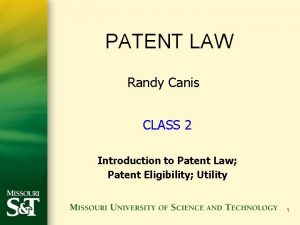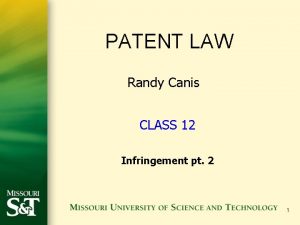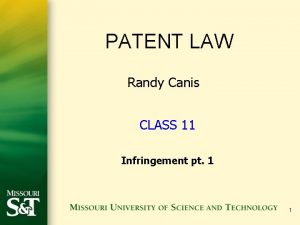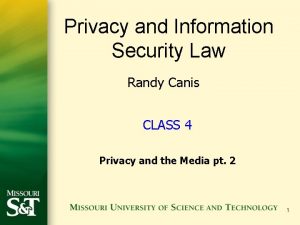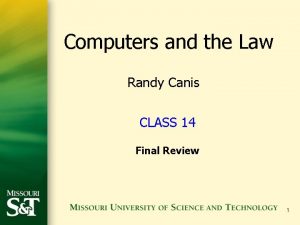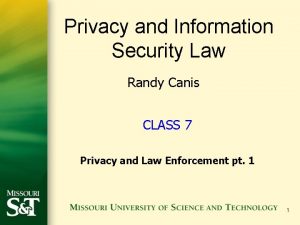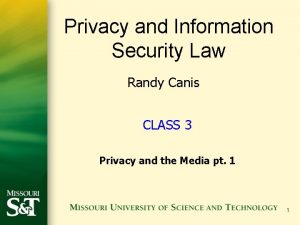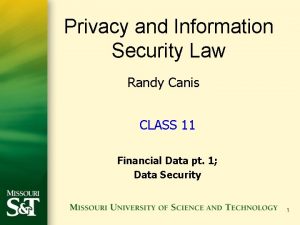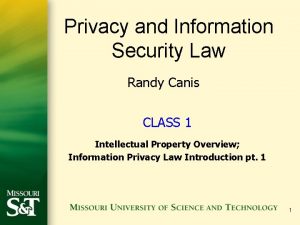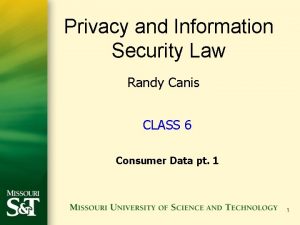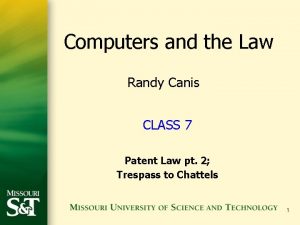PATENT LAW Randy Canis CLASS 14 Final Review












![In Re Fisher • “[T]o satisfy the ‘substantial’ utility requirement, an asserted use must In Re Fisher • “[T]o satisfy the ‘substantial’ utility requirement, an asserted use must](https://slidetodoc.com/presentation_image_h/86dbb2d391dc503a0336b2fd9554621a/image-13.jpg)


![CLS Bank International v. Alice Corporation Pty. Ltd. • “[W]e need not labor to CLS Bank International v. Alice Corporation Pty. Ltd. • “[W]e need not labor to](https://slidetodoc.com/presentation_image_h/86dbb2d391dc503a0336b2fd9554621a/image-16.jpg)











![Arranged in the Claim • “[T]he prior art reference in order to anticipate under Arranged in the Claim • “[T]he prior art reference in order to anticipate under](https://slidetodoc.com/presentation_image_h/86dbb2d391dc503a0336b2fd9554621a/image-28.jpg)







![In re Hall • “[P]ublic accessibility” has been called the touchstone in determining whether In re Hall • “[P]ublic accessibility” has been called the touchstone in determining whether](https://slidetodoc.com/presentation_image_h/86dbb2d391dc503a0336b2fd9554621a/image-36.jpg)







![Gillman v Stern • [A secret use] is clearly not a ‘public’ one, and Gillman v Stern • [A secret use] is clearly not a ‘public’ one, and](https://slidetodoc.com/presentation_image_h/86dbb2d391dc503a0336b2fd9554621a/image-44.jpg)






![Nonobviousness “[A]n invention must also sufficiently advance the useful arts in order to warrant Nonobviousness “[A]n invention must also sufficiently advance the useful arts in order to warrant](https://slidetodoc.com/presentation_image_h/86dbb2d391dc503a0336b2fd9554621a/image-51.jpg)


![Post-KSR • “[A]s the Supreme Court suggests, a flexible approach to the TSM test Post-KSR • “[A]s the Supreme Court suggests, a flexible approach to the TSM test](https://slidetodoc.com/presentation_image_h/86dbb2d391dc503a0336b2fd9554621a/image-54.jpg)







![Magsil Corp. and MIT v. Hitachi • “[T]he specification at the time of filing Magsil Corp. and MIT v. Hitachi • “[T]he specification at the time of filing](https://slidetodoc.com/presentation_image_h/86dbb2d391dc503a0336b2fd9554621a/image-62.jpg)



![Datamize, LLC v. Plumtree Software, Inc. • “[T]he purpose of the definiteness requirement is Datamize, LLC v. Plumtree Software, Inc. • “[T]he purpose of the definiteness requirement is](https://slidetodoc.com/presentation_image_h/86dbb2d391dc503a0336b2fd9554621a/image-66.jpg)

![Media Rights Technologies, Inc. v. Capital One Financial Corp. • “[A] claim is indefinite Media Rights Technologies, Inc. v. Capital One Financial Corp. • “[A] claim is indefinite](https://slidetodoc.com/presentation_image_h/86dbb2d391dc503a0336b2fd9554621a/image-68.jpg)






























![Therasense, Inc. v. Becton, Dickinson & Co. • “[T]he accused infringer must prove by Therasense, Inc. v. Becton, Dickinson & Co. • “[T]he accused infringer must prove by](https://slidetodoc.com/presentation_image_h/86dbb2d391dc503a0336b2fd9554621a/image-99.jpg)










![Festo Corp. v. Shoketsu Kinzoku Holding on Issue #1 • “… [A] narrowing amendment Festo Corp. v. Shoketsu Kinzoku Holding on Issue #1 • “… [A] narrowing amendment](https://slidetodoc.com/presentation_image_h/86dbb2d391dc503a0336b2fd9554621a/image-110.jpg)




![Akamai Technologies, Inc. v. Limelight Networks, Inc. • “[T]here has simply been no infringement Akamai Technologies, Inc. v. Limelight Networks, Inc. • “[T]here has simply been no infringement](https://slidetodoc.com/presentation_image_h/86dbb2d391dc503a0336b2fd9554621a/image-115.jpg)





![In re Seagate • “[T]o establish willful infringement, a patentee must show by clear In re Seagate • “[T]o establish willful infringement, a patentee must show by clear](https://slidetodoc.com/presentation_image_h/86dbb2d391dc503a0336b2fd9554621a/image-121.jpg)
![Madey v. Duke • “[U]se does not qualify for the experimental use defense when Madey v. Duke • “[U]se does not qualify for the experimental use defense when](https://slidetodoc.com/presentation_image_h/86dbb2d391dc503a0336b2fd9554621a/image-122.jpg)




![Shop Right • “… [T]he right of an employer to use employee’s invention in Shop Right • “… [T]he right of an employer to use employee’s invention in](https://slidetodoc.com/presentation_image_h/86dbb2d391dc503a0336b2fd9554621a/image-127.jpg)













![Ordinary Observer Infringement Test • "[I]f, in the eye of an ordinary observer, giving Ordinary Observer Infringement Test • "[I]f, in the eye of an ordinary observer, giving](https://slidetodoc.com/presentation_image_h/86dbb2d391dc503a0336b2fd9554621a/image-141.jpg)




- Slides: 145

PATENT LAW Randy Canis CLASS 14 Final Review 1

Final Exam Info • Final Exam format – 50 multiple choice questions + bonus questions – 2 points per question – All answers to be completed in Excel document provided on website – Use capital letters for your answer 2

Final Exam Info • Grading – I will not acknowledge receipt of your graded exam immediately. – However, I will respond within 24 hours of receipt of your exam with your final grade – I will not advise you of which questions you scored correctly or incorrectly on the final exam, nor do I send an answer key – However, if you did not receive the grade you expected to receive, I am willing to go over missed questions with you. 3

Final Exam Info • Thus, you have an incentive to turn in the final exam early so that you can get your grade early and address any issues before your final exam grade is entered. • I reserve my right to enter final grades for all students at the day and time that the exam is due. • DO NOT TURN IN YOUR EXAM LATE OR, AMOUNG OTHER THINGS, YOUR COURSE GRADE COULD BE DELAYED • Any further questions about the final exam? 4

Final Review • What did we learn this semester? • Let’s review… 5

Branches of U. S. Government (3) Legislative Executive Judicial Body Congress Pres & Admin Agencies Federal Courts Role “Make” “Enforce” “Interpret” Regulations Case Opinions Federal Register and C. F. R. Case Reporters “Product” Statutes Location U. S. Code 6

Federal Court Structure • US Supreme Court (1) • US Court of Appeals (13) – 8 th Circuit – Federal Circuit • US District Courts (144); at least 1 per state – Missouri - 2 Federal District Courts • • • Eastern District - St. Louis Western District - Kansas City + Federal Bankruptcy Court 7

Jurisdictional Requirements • What is jurisdiction? – the power of a court to decide a matter in controversy (i. e. , a case) • What is needed to establish jurisdiction? – Authority of the court to hear the case (e. g. , original or appellate jurisdiction) – Authority of the court over the subject matter (subject matter jurisdiction) – Jurisdiction over the parties (personal jurisdiction) or property (in rem jurisdiction) of the suit – Proper notice • 8 8

Types of Intellectual Property • Unfair Competition • Right of Publicity • Trademarks • Trade Secrets • Patent • Copyright Note: Lay people often erroneously term one type of intellectual property by another name, such as copyrighting a name, patenting a music CD, trademarking an invention, etc. 9

§ 101 10

§ 101 – Inventions Patentable • Whoever invents or discovers any new and useful process, machine, manufacture, or composition of matter, or any new and useful improvement thereof, may obtain a patent therefor, subject to the conditions and requirements of this title 11

Lowell v. Lewis • “All that the law requires is, that the invention should not be frivolous or injurious to the well-being, good policy, or sound morals of society. ” • The patent system is not looking for something better, but rather is just looking for something different. 12
![In Re Fisher To satisfy the substantial utility requirement an asserted use must In Re Fisher • “[T]o satisfy the ‘substantial’ utility requirement, an asserted use must](https://slidetodoc.com/presentation_image_h/86dbb2d391dc503a0336b2fd9554621a/image-13.jpg)
In Re Fisher • “[T]o satisfy the ‘substantial’ utility requirement, an asserted use must show that claimed invention has a significant and presently available benefit to the public. ” 13

Patent Eligibility • Is a particular invention of a kind that the patent laws intended to protect? • Subject matter open to patenting – Are there subject matters that are not open to patenting? • Natural Laws • Phenomena of Nature • Abstract Principles • Technology = useful arts 14

Association for Molecular Pathology v. Myriad • “We merely hold that genes and the information they encode are not patent eligible under § 101 simply because they have been isolated from the surrounding genetic material. ” 15
![CLS Bank International v Alice Corporation Pty Ltd We need not labor to CLS Bank International v. Alice Corporation Pty. Ltd. • “[W]e need not labor to](https://slidetodoc.com/presentation_image_h/86dbb2d391dc503a0336b2fd9554621a/image-16.jpg)
CLS Bank International v. Alice Corporation Pty. Ltd. • “[W]e need not labor to delimit the precise contours of the “abstract ideas” category in this case. It is enough to recognize that there is no meaningful distinction between the concept of risk hedging in Bilski and the concept of intermediated settlement at issue here. Both are squarely within the realm of ‘abstract ideas’ as we have used that term. ” 16

CLS Bank International v. Alice Corporation Pty. Ltd. • “A claim that recites an abstract idea must include ‘additional features’ to ensure ‘that the [claim] is more than a drafting effort designed to monopolize the [abstract idea]. ’ … Mayo made clear that transformation into a patenteligible application requires “more than simply stat[ing] the [abstract idea] while adding the words ‘apply it. ’” …” 17

Abstract Ideas • “Abstract ideas have been identified by the courts by way of example, including fundamental economic practices, certain methods of organizing human activities, an idea ‘of itself, ’ and mathematical relationships/formulas. ” 18

19

Abstract Idea? • “A claim to a process, machine, manufacture or composition of matter (Step 1: YES) that is not directed to any judicial exceptions (Step 2 A: NO) is eligible and needs no further eligibility analysis. ” 20

2014 Patent Eligibility Guidance and Abstract Idea Examples • 1. Determine What the Claim Is “Directed to” – “A claim is directed to a judicial exception when a law of nature, a natural phenomenon, or an abstract idea is recited (i. e. , set forth or described) in the claim. Such a claim requires closer scrutiny for eligibility because of the risk that it will ‘tie up’ [] the excepted subject matter and pre-empt others from using the law of nature, natural phenomenon, or abstract idea. ” 21

2014 Patent Eligibility Guidance and Abstract Idea Examples • 2. Identify the Judicial Exception Recited in the Claim – abstract ideas, laws of nature, and natural phenomena – “Abstract ideas have been identified by the courts … including fundamental economic practices, certain methods of organizing human activities, an idea ‘of itself, ’ and mathematical relationships/formulas. ” 22

§ 102 23

102 • As of 2013, the U. S. patent system operates under two parallel novelty standards – 1952 Act – Novelty defined from the date of invention – AIA – Novelty measured as of the date a patent is first filed 24

Definitions • Reference – qualification of a publication or patent filing as prior art under one of 102 sections • Effective date – time when the reference is considered to be prior art 25

Anticipation • An invention must be new at conception by an original inventor to be patentable. • An invention is anticipated if someone else has already invented the invention. 26

Anticipation • “If the claimed invention can be found within the ambit of a single prior art reference, then the invention has been anticipated. References may not be combined during this inquiry, nor may elements that are analogous to the disclosure of a reference be considered. ” 27
![Arranged in the Claim The prior art reference in order to anticipate under Arranged in the Claim • “[T]he prior art reference in order to anticipate under](https://slidetodoc.com/presentation_image_h/86dbb2d391dc503a0336b2fd9554621a/image-28.jpg)
Arranged in the Claim • “[T]he prior art reference in order to anticipate under 35 U. S. C. § 102 must not only disclose all elements of the claim within the four corners of the document, but must also disclose those elements ‘arranged as in the claim. ’” • Connell v. Sears, Roebuck & Co. , 722 F. 2 d 1542, 1548 (Fed. Cir. 1983). 28

Schering Corp. v. Geneva Pharmaceuticals, Inc. • “A patent is invalid for anticipation if a single prior art reference discloses each and every limitation of the claimed invention. … Moreover, a prior art reference may anticipate without disclosing a feature of the claimed invention if that missing characteristic is necessarily present, or inherent, in the single anticipating reference. ” 29

102 Analysis • “The AIA provides a person is not entitled to a patent if: • (1) the claimed invention was patented, described in a printed publication, or in public use, on sale, or otherwise available to the public before its effective filing date (§ 102(a)(1)); and • (2) the claimed invention was described in a published application or issued patent that names another inventor and was filed prior to the filing date of the claimed invention (§ 102(a)(2)). ” 30

One Year Grace Period? • “AIA § 102(b)(1) provides a one-year grace period after a first disclosure of an invention within which to file a patent application. ” 31

Metallizing Engineering Co. v. Kenyon Bearing & Auto Parts • “… it is a condition upon an inventor’s right to a patent that he shall not exploit his discovery competitively after it is ready for patenting; he must content himself with either secrecy, or legal monopoly. ” 32

Statutory Bars (pre-AIA) § 102. Conditions for patentability; novelty and loss of right to patent A person shall be entitled to a patent unless — (b) the invention was patented or described in a printed publication in this or a foreign country or in public use or on sale in this country, more than one year prior to the date of the application for patent in the United States, or 33

Pfaff v. Wells Electronics, Inc. • “On Sale” Test 1) The product must be the subject of a commercial offer for sale 2) The invention must be ready for patenting • Proof of reduction to practice before the critical date; or • Proof that prior to the critical date the inventor had prepared drawings or other descriptions of the invention that were sufficiently specific to enable a person skilled in the art to practice the invention 34

The Medicines Company v. Hospira, Inc. • “We have held that ‘the question of whether an invention is the subject of a commercial offer for sale is a matter of Federal Circuit law, to be analyzed under the law of contracts as generally understood. ’ … We also have held that, to be true to Pfaff when assessing prong one of § 102(b), we must focus on those activities that would be understood to be commercial sales and offers for sale ‘in the commercial community. ’” 35
![In re Hall Public accessibility has been called the touchstone in determining whether In re Hall • “[P]ublic accessibility” has been called the touchstone in determining whether](https://slidetodoc.com/presentation_image_h/86dbb2d391dc503a0336b2fd9554621a/image-36.jpg)
In re Hall • “[P]ublic accessibility” has been called the touchstone in determining whether a reference constitutes a “printed publication” bar under 35 U. S. C. § 102(b) … The proponent of the publication bar must show that prior to the critical date the reference was sufficiently accessible … so that such a one by examining the reference could make the claimed invention without further research or experimentation. ” 36

Grace Periods • AIA – § 102(b) provides exceptions to § 102(a) when the subject matter was previously disclosed directly from the inventor or indirectly (e. g. , through someone else) who received the information from the inventor) • Pre-AIA – Broader grace period 37

How Does the Grace Period Work? • Inventor must disclose the invention publicly first – Less than one year before filing – Before a third-party discloses • How will proof of disclosure be measured? – Don’t know • Is experimental use still a viable exception? – Don’t know 38

Obvious Subject Matter • The AIA grace period only protects the novelty of publicly disclosed subject matter. • If a third party subsequently publicly discloses an obvious variation of the subject matter, that variation becomes prior art against the inventor who was otherwise first in time to publicly disclose. 39

City of Elizabeth v. American Nicholson Pavement Co. • “So long as he does not voluntarily allow others to make it and use it, and so long as it is not on sale for general use, he keeps the invention under his own control, and does not lose his title to the patent. ” • “But if the inventor allows his machine to be used by other persons generally, either with or without compensation, or if it is, with his consent, put on sale for such use, then it will be in public use and on public sale, within the meaning of the law. ” 40

Experimental Use • As a general rule, an experimental use only negates a statutory bar when the inventor was testing claimed features of the invention. • Courts view the totality of the circumstances when determining whether an invention was on sale or in public use • The experimental use exception does not include market testing. 41

W. L. Gore & Associates v. Garlock • The secret commercialization of a product or method by a third party does not provide a statutory basis to bar an applicant from obtaining a patent on the product or method. 42

AIA Changes • Public Use and On Sale bar – § 102(b)(pre-AIA) – US only – § 102(a)(1) – anywhere • Otherwise available to the public – § 102(b) – no such language – § 102(a)(1) – language included; exact meaning and potential limiting effect on other language unknown • Grace period applicability – § 102(b) – grace period prevents bar when activity by inventor or other took place was less than a year – § 102(a)(1) - § 102(b)(1) only prevents bars when activity by inventor took place less than a year; all third party activity creates a bar 43
![Gillman v Stern A secret use is clearly not a public one and Gillman v Stern • [A secret use] is clearly not a ‘public’ one, and](https://slidetodoc.com/presentation_image_h/86dbb2d391dc503a0336b2fd9554621a/image-44.jpg)
Gillman v Stern • [A secret use] is clearly not a ‘public’ one, and such an inventor is not a ‘first inventor’. ” 44

“Swearing Behind” a Reference • Under rule 131 (pre-AIA) – Applicants can declare an invention date prior to the date of a prior art reference. – Termed “swearing behind” or “antedating” a prior art reference – Can overcome a 102(a) or 102(e) rejection – Cannot overcome a 102(b) rejection—why? • Invention date is revealed on an ad hoc basis 45

Patent Interference Applicability • If two or more applications are filed in the PTO for the same invention, a complicated set of proceedings called an INTERFERENCE PROCEEDING. Interference between: – two or more PENDING APPLICATIONS or – between PENDING APPLICATION AND ISSUED PATENT if during the first year after patent issued when declared by patent examiner or provoked by patent applicant 46

Reduction to Practice • Reduction to practice by: 1) Constructively – by filing a patent application 2) Actually – by building and testing a physical embodiment of the invention 47

Woodland Trust v. Flowertree Nursery, Inc. • • Corroboration of oral evidence of prior invention is the general rule in patent disputes. What criteria did the court use in assessing corroboration? 48

§ 102(e)(pre-AIA) • The prior art patents and publications count as prior art based on their filing date, not the publication date or issue date • Differences with § 102(a)(2)(a) – Rule 131 possible pre-AIA; not possible under AIA – First actual filing date in the US v. priority date anywhere in the world 49

§ 103 50
![Nonobviousness An invention must also sufficiently advance the useful arts in order to warrant Nonobviousness “[A]n invention must also sufficiently advance the useful arts in order to warrant](https://slidetodoc.com/presentation_image_h/86dbb2d391dc503a0336b2fd9554621a/image-51.jpg)
Nonobviousness “[A]n invention must also sufficiently advance the useful arts in order to warrant the award of an exclusive right. … In terms of obviousness, the new combination does not warrant a patent if, from the vantage point of one of ordinary skill in the art at the time of the invention, this new combination would have been obvious. ” 51

Graham v. John Deere Co. • “Under § 103, the scope and content of the prior art are to be determined; differences between the prior art and the claims at issue are to be ascertained; and the level of ordinary skill in the art resolved. … Such secondary considerations as commercial success, long felt but unresolved needs, failure of others, etc. , might be utilized to give light to the circumstances surrounding the origin of the subject matter sought to be patented. ” 52

KSR v. Teleflex – Supreme Court • Supreme Ct – Rejects rigid approach; expansive and flexible approach – “[T]he Court has held that a ‘patent for a combination which only unites old elements with no change in their respective functions. . . obviously withdraws what is already known into the field of its monopoly and diminishes the resources available to skillful men. ’. . . – “The combination of familiar elements according to known methods is likely to be obvious when it does no more than yield predictable results. ” 53
![PostKSR As the Supreme Court suggests a flexible approach to the TSM test Post-KSR • “[A]s the Supreme Court suggests, a flexible approach to the TSM test](https://slidetodoc.com/presentation_image_h/86dbb2d391dc503a0336b2fd9554621a/image-54.jpg)
Post-KSR • “[A]s the Supreme Court suggests, a flexible approach to the TSM test prevents hindsight and focuses on evidence before the time of invention, without unduly constraining the breadth of knowledge available to one of ordinary skill in the art during the obviousness analysis. ” • In re Translogic Technology, Inc. , 504 F. 3 d 1249 (Fed. Cir. 2007) 54

Analogous Arts • “Two criteria have evolved for determining whether prior art is analogous: • (1) whether the art is from the same field of endeavor, regardless of the problem addressed, and • (2) if the reference is not within the field of the inventor’s endeavor, whether the reference is still reasonable pertinent to the particular problem with which the inventor is involved. ” In re Clay, 966 F. 2 d 656 (Fed. Cir. 1992) 55

2007 Obviousness Guidelines (1) Combining prior art elements according to known methods to yield predictable results; (2) Simple substitution of one known element for another to obtain predictable results; (3) Use of a known technique to improve similar devices, methods, or products in the same way; (4) Applying a known technique to a known device, method, or product ready for improvement to yield predictable results; (5) Obvious to try— choosing from a finite number of identified, predictable solutions, with a reasonable expectation of success; and (6) Known work in one field of endeavor may prompt variations of it for use in either the same field or a different one based on design incentives or other market forces if the variations are predictable to one of ordinary skill in the art. • Any rationale employed must provide a link between the factual findings and the legal conclusion of obviousness. 56

Categorization of Cases in the 2010 Examination Guidelines • Combining Prior Art Elements • Substituting One Known Element for Another • Obvious to Try Rationale • Consideration of Evidence 57

§ 112 58

Specification 59

Patent Specification Requirements 35 U. S. C. § 112 requires that the Specification of a patent application must contain: (A) A written description of the invention; (B) The manner and process of making and using the invention (the enablement requirement); and (C) The best mode contemplated by the inventor of carrying out the invention. M. P. E. P. 2161 60

Enablement Requirement • The specification must teach someone of skill in the art (1) how to make and (2) how to use the invention without undue experimentation. • MPEP 2164 61
![Magsil Corp and MIT v Hitachi The specification at the time of filing Magsil Corp. and MIT v. Hitachi • “[T]he specification at the time of filing](https://slidetodoc.com/presentation_image_h/86dbb2d391dc503a0336b2fd9554621a/image-62.jpg)
Magsil Corp. and MIT v. Hitachi • “[T]he specification at the time of filing must teach one of ordinary skill in the art to fully perform this method across that entire scope. ” 62

Written Description Requirement • To satisfy the written description requirement, a patent specification must describe the claimed invention in sufficient detail that one skilled in the art can reasonably conclude that the inventor had possession of the claimed invention. • MPEP 2163 63

Written Description Violations • Broad Claims • Claims cannot cover inventions never contemplated or disclosed by the inventor • Narrow Claims • Each limitation must be supported by written description • Addition of New Matter • To obtain benefit of earlier-filed application, claims of a continuation (or CIP) must be supported by original specification 64

Chemcast Corp. v. Arco Industries Corp. • Test 1. At the time the inventor filed his patent application, did the inventor know of a mode of practicing the claimed invention that he/she considered to be better than any other? 2. If so contemplated, is the disclosure adequate to enable one skilled in the art to practice the best mode (i. e. , has the best mode been concealed)? 65
![Datamize LLC v Plumtree Software Inc The purpose of the definiteness requirement is Datamize, LLC v. Plumtree Software, Inc. • “[T]he purpose of the definiteness requirement is](https://slidetodoc.com/presentation_image_h/86dbb2d391dc503a0336b2fd9554621a/image-66.jpg)
Datamize, LLC v. Plumtree Software, Inc. • “[T]he purpose of the definiteness requirement is to ensure that the claims delineate the scope of the invention using language that adequately notifies the public of the patentee’s right to exclude” 66

Nautilus, Inc. v. Biosig Instruments, Inc. • “In place of the ‘insolubly ambiguous’ standard, we hold that a patent is invalid for indefiniteness if its claims, read in light of the specification delineating the patent, and the prosecution history, fail to inform, with reasonable certainty, those skilled in the art about the scope of the invention. ” 67
![Media Rights Technologies Inc v Capital One Financial Corp A claim is indefinite Media Rights Technologies, Inc. v. Capital One Financial Corp. • “[A] claim is indefinite](https://slidetodoc.com/presentation_image_h/86dbb2d391dc503a0336b2fd9554621a/image-68.jpg)
Media Rights Technologies, Inc. v. Capital One Financial Corp. • “[A] claim is indefinite if its language ‘might mean several different things and no informed and confident choice is available among the contending definitions. ’” 68

Claims 69

Ex Parte Fressola • “The mere reference to the body of the specification by the terms ‘substantially in the manner described’ is not ‘particularly’ pointing out and ‘distinctly’ claiming the alleged invention, and therefore does not comply with the requirements of the statute. ” • “The description includes large quantities of extraneous matter … which obscures the … claim boundaries…” 70

Elemental Claim Structure Three basic parts of a claim: 1) A preamble 2) A transition phrase 3) A body 71

The Preamble • “Immediately stated at the beginning of the claim is the object of the sentence, e. g. , ‘A method of making coffee …’ The introduction (‘preamble’) may or may not constitute a limitation to the scope of the claim. ” “… a preamble is a limitation if it gives ‘meaning to the claim’ …” 72

The Open Transition “The Open Transition (‘comprising’): The use of the term ‘comprising’ captures technologies with all the elements described in the body of the claim; whether the technology has additional elements is irrelevant. Thus, if a claim recites elements ‘A’ and ‘B’, a device with ‘A’, ‘B’ and others is an infringement. ” 73

The Closed Transition “The Closed Transition (‘consisting of’): In contrast, a claim which employs the term ‘consisting of’ is ‘closed’ to additional ingredients. Infringement can occur only when the accused technology has exactly the same elements recited in the claimno more or no less. ” 74

The Hybrid Transition “The Hybrid Transition (‘consisting essentially of’): … This terminology renders the claim “open” to include additional elements that do not materially affect the basic and novel characteristics of the claimed combination. ” 75

The Body Relation of Elements • “The body of the claim provides the elements of the invention, as well as how these elements cooperate either structurally or functionally. ” • “The drafter should also indicate how [each] element interacts with the [other elements] to form an operative technology …” 76

The Body Element Introduction • “Elements of an invention are ordinarily introduced with indefinite article, such as ‘a’ or ‘an, ’ as well as terms such as ‘one, ’ ‘several, ’ or ‘a plurality of. ’ When that element is noted later in the claim, claims drafters ordinarily employ the definite article ‘the’ or the term ‘said. ’” • “If an element appearing for the first time is accompanied by ‘the’ or ‘said, ’ then it will ordinarily be rejected by an examiner as lacking so-called ‘antecedent basis. ’” 77

Product by Process Claims • When an invention can be described in no other way besides the way of making a product (i. e. , structural characteristics cannot adequately describe the invention) • Defines the product by the process of making it 78

Means-Plus-Function Format “It requires the applicant to describe in the patent specification the various structures that the inventor expects to perform the specified function. The statute then expressly confines coverage of the functional claim language to ‘corresponding structure, material, or acts described in the specification and equivalents 79 thereof. ”

Williamson v. Citrix • “Henceforth, we will apply the presumption as we have done prior to Lighting World, without requiring any heightened evidentiary showing and expressly overrule the characterization of that presumption as ‘strong. ’ We also overrule the strict requirement of ‘a showing that the limitation essentially is devoid of anything that can be construed as structure. ’” 80

Aristocrat Technologies Australia Pty Ltd. v. International Game Technology • What should/could Aristocrat have done? – Disclosed the algorithm – Avoided using means-plus-function format for claim element 81

Jepson Claim • Defines an invention in two parts: – A preamble which recites the admitted prior art, – Followed by an “improvement” clause which recites what the applicant regards as his invention • Referred to as a two-part claim in other parts of the world – Most popular in Germany 82

Prosecution 83

General Prosecution Overview • Step 0 – Prepare an invention disclosure form • Step 1 – Identifying person to draft (and likely prosecute) patent application – Applicant – Patent attorney or agent • Step 2 – Prior Art search – Not required… but highly recommended • Step 3 – Determine whether an application should be filed – Provisional – Nonprovisional • Step 4 – Prepare and file the application • Step 5 – Prosecution (including possible appeal(s)) • Step 6 – Allowance or Abandonment • Step 7 – Continuation Applications (prior to issuance or abandonment)? 84

Office Action Summarizes the findings of examiner • As to each claim specifically – each claim is rejected, allowed, objected to indicating allowable if rewritten in independent form • Any objections to the drawings, specification, title, or abstract are included • The office action could also include a double patenting rejection 85

Office Action date & response Has a date of mailing and from that date sets a date for response by applicant: • Typically 3 mo. for substantive rejections or • Shorter (e. g. , 1 or 2 mo. ) for informal requirements such as requiring applicant to elect between different species of claimed inventions regarded by examiner as independent (e. g. , method and apparatus) 86

Provisional versus Nonprovisional Provisional • Less preparation time Nonprovisional • More preparation time • Can not amend • Amendments are possible • No claims required • Must have at least 1 claim • Not examined • Examined • Informal • More formal • Valid for only 1 year; must timely file • Application valid until nonprovisional claiming abandoned or patent issued priority 87

Continuation Possibilities • Continuation – might claim other aspects disclosed but not claimed, or claimed in the same way as rejected claims • Request for Continuing Examination (RCE) – removes finality of the office action (e. g. , pay to play) 88

Choices Other Than Continuation(s) • Appeal to Patent Trial and Appeal Board (PTAB) – Appeal is statutory (35 USC 134) – Issues re examiner's rejection of claims when level of invention &/or interp. of art in question – Tribunal is three senior examiners; considers: • Applicant’s Brief on Appeal • Examiner’s Brief on Appeal – Decides/remands to exam’r for further exam’n – Further appeal possible to Fed. Cir. Ct. of Appeals – http: //www. uspto. gov/ip/boards/bpai/index. jsp 89

Publication of patent applications • 18 months after filing unless applicant requests otherwise upon filing & certifies has not & won’t be subject of an application filed in a foreign country • Provisional rights available to patentees to obtain reasonable royalties if others make, use, sell, or import invention in the period between publication and grant • Applicant can consider if foreign counterparts will be sought after all, after non-publication request (NPR). • If applicant then files foreign patent, must notify PTO in US application within 60 days & withdraw NPR. Application then is published ASAP • PRIOR ART effect for published applications -Sec. 102(e) • http: //www. uspto. gov/web/offices/pac/mpep/s 1120. html 90

Term of Patent • Patent will issue to be in effect 20 years from: – Date of first filing of this or parent application – Or as limited by delays of applicant during prosecution – E. g. , extensions of time required by applicant – Or as limited by the lapse of a parent application – Or where terminal disclaimer was submitted to overcome a double patenting rejection • Patent is subject to maintenance fees payable 3. 5, 7. 5 & 11. 5 years after issuance 91

Term of Patent • Continuing applications – 20 years from earliest filing date for which a benefit is claimed • Based off of an international application – 20 years from filing date of international application—not the US application (unless priority dates back to original US nonprovisional application) • Foreign priority – Not considered in term • Provisional application – Not considered in term 92

Inventorship • Applications must be filed in the name of the true inventors • Inventors must sign a declaration or an oath stating that they believe they are the first inventors. • Joint inventorship of an invention is possible. • http: //www. uspto. gov/web/offices/pac/m pep/s 2137. html 93

Important Right of Joint Inventors • "In the absence of an agreement to the contrary, each of the owners of patent may make, use, offer to sell, or sell the patented invention with the United States, or import [it], without the consent of and without accounting to the other owners. " [Section 262 of Patent Statutes (35 U. S. C. 262)] 94

Non-Statutory Double Patenting In such instances issues of double patenting often overcome by use of terminal disclaimer: · Term of second patent after expiration of first patent is disclaimed. · Both patent then expire on the same date. · Both patents must remain commonly owned. 95

Duty of Disclosure § Types of Materials to be Disclosed: § § Known Prior Art in Related US Matters Prior Art in Related Foreign Matters Advise PTO of related matters 96

Current Method of Disclosure • Applicants submit one or more information disclosure statements (IDS) during prosecution to make the USPTO aware of any prior art 97

Therasense, Inc. v. Becton, Dickinson & Co. • “To prevail on a claim of inequitable conduct, the accused infringer must prove that the patentee acted with the specific intent to deceive the PTO. … A finding that the misrepresentation or omission amounts to gross negligence or negligence under a ‘should have known’ standard does not satisfy this intent requirement. ” 98
![Therasense Inc v Becton Dickinson Co The accused infringer must prove by Therasense, Inc. v. Becton, Dickinson & Co. • “[T]he accused infringer must prove by](https://slidetodoc.com/presentation_image_h/86dbb2d391dc503a0336b2fd9554621a/image-99.jpg)
Therasense, Inc. v. Becton, Dickinson & Co. • “[T]he accused infringer must prove by clear and convincing evidence that the applicant knew of the reference, knew that it was material, and made a deliberate decision to withhold it. ” 99

Reissue/Reexamination Correction of Substantive Errors • Reissue – applicants correction of more significant errors affecting the validity and enforceability of an issued patent • Reexamination – allows applicants or third parties to request that the PTO reconsider the validity of the patent 100

Reissue Rules • Can seek broader claims (only w/in 2 yrs. of issue) or narrower claims • Cannot be used to correct inequitable conduct in original prosecution • Cannot recapture claim given up in original prosecution • Can’t defeat "intervening rights" of another who relied upon original claims. Broadened reissue claims can’t be enforced against another who designed structure outside original claims • Reissue petition need not point out any error • Reissue has risk of involvement in interference 101

AIA Post-Grant Proceedings • Post-Grant Review (PGR) • Inter Partes Review (IPR) • Transitional Program for Covered Business Methods (CBM) • Supplemental Examination • Derivation Proceedings 102

Infringement 103

Infringement Sec. 271. - Infringement of patent (a) Except as otherwise provided in this title, whoever without authority makes, uses, offers to sell, or sells any patented invention, within the United States, or imports into the United States any patented invention during the term of the patent therefor, infringes the patent. (b) Whoever actively induces infringement of a patent shall be liable as an infringer. [Active Inducement] (c) Whoever offers to sell or sells within the United States or imports into the United States a component of a patented machine, manufacture, combination, or composition, or a material or apparatus for use in practicing a patented process, constituting a material part of the invention, knowing the same to be especially made or especially adapted for use in an infringement of such patent, and not a staple article or commodity of commerce suitable for substantial noninfringing use, shall be liable as a contributory infringer. [Contributory Infringement] 104

Markman v. Westview Instruments, Inc. • “An infringement analysis entails two steps. The first step is determining the meaning and scope of the patent claims asserted to be infringed. The second step is comparing the properly constructed claims to the device accused of infringing. ” • “… [I]n a case tried to a jury, the court has the power and obligation to construe as a matter of law the meaning of language used in the patent claim. ” 105

Teva Pharmaceuticals USA, Inc. v. Sandoz, Inc. • “The appellate court can still review the district court’s ultimate construction of the claim de novo. But, to overturn the judge’s resolution of an underlying factual dispute, the Court of Appeals must find that the judge, in respect to those factual findings, has made a clear error. Fed. Rule Civ. Proc. 52(a)(6). ” 106

Infringement Under the Doctrine Equivalents • First Inquiry - Does a device or method literally infringe one or more claims of a patent? • Second Inquiry - Does a device or method infringe one or more claims of a patent under the doctrine of equivalents (DOE)? 107

Graver Tank & Mfg. Co. v. Linde Air Products Co. • Function-Way Result a/k/a “Triple Identity” Test • “[A] patentee may invoke this doctrine to proceed against the producer of a device ‘if it performs substantially the same function in substantially the same way to obtain the same result. ’ … The theory on which it is founded is that ‘if two devices do the same work in substantially the same way, and accomplish substantially the same result, they are the same, even though they differ in name, form, or shape. ’” 108

Warner-Jenkinson Company v. Hilton Davis Chemical Co. • “One of ordinary skill in the relevant art provides the perspective for assessing the substantiality of differences between the claims and the accused device. . `The test is objective with proof of the substantiality of the differences resting on objective evidence. ' …” 109
![Festo Corp v Shoketsu Kinzoku Holding on Issue 1 A narrowing amendment Festo Corp. v. Shoketsu Kinzoku Holding on Issue #1 • “… [A] narrowing amendment](https://slidetodoc.com/presentation_image_h/86dbb2d391dc503a0336b2fd9554621a/image-110.jpg)
Festo Corp. v. Shoketsu Kinzoku Holding on Issue #1 • “… [A] narrowing amendment made to satisfy any requirement of the Patent Act may give rise to an estoppel. ” • A patentee who narrows a claim as a condition for obtaining a patent disavows his claim to the broader subject matter, whether the amendment was made to avoid the prior art (not for other reasons tangential to patentability). In either event. . . estoppel can apply as to elements narrowed by amendment. 110

Festo Corp. v. Shoketsu Kinzoku Holding on Issue #2 • Prosecution history estoppel is not a complete bar to assertion of the doctrine of equivalents. … “Warner-Jenkinson held that the patentee bears the burden of proving that an amendment was not made for a reasons that would give rise to estoppel, we hold here that the patentee should bear the burden of showing that the amendment does not surrender the particular equivalent in question. ” 111

Federal Circuit decision in Festo Court spelled out three circumstances in which presumption could be rebutted: (1) where the accused equivalent was unforeseeable at the time of amdt. (2) where amdt. bore no more than a “tangential relation” to accused equiv. , or (3) where “some other reason” prevented patentee from describing accused equivalent in the patent appl. 112

Beyond Direct Infringement INDIRECT INFRINGEMENT • Active Inducement (§ 271(b)) – “Whoever actively induces infringement of a patent shall be liable as an infringer. ” • Contributory Infringement (§ 271(c)) – “Whoever offers to sell or sells within the United States or imports into the United States a component of a patented machine, manufacture, combination or composition, or a material or apparatus for use in practicing a patented process, constituting a material part of the invention, knowing the same to be especially made or especially adapted for use in an infringement of such patent, and not a staple article or commodity of commerce suitable for substantial noninfringing use, shall be liable as a contributory infringer. ” 113

Divided/Joint Infringement Basics • Must a single party perform all actions to infringe? • What if a first party performs almost all steps, and the first party contracts with a second party to perform one or two of the steps, should the first party (or the second party) still infringe? If so, under what circumstances? • General rule – if the second party engaged with the first party to perform actions at an arms length transaction, the first party (and the second party do not infringe) 114
![Akamai Technologies Inc v Limelight Networks Inc There has simply been no infringement Akamai Technologies, Inc. v. Limelight Networks, Inc. • “[T]here has simply been no infringement](https://slidetodoc.com/presentation_image_h/86dbb2d391dc503a0336b2fd9554621a/image-115.jpg)
Akamai Technologies, Inc. v. Limelight Networks, Inc. • “[T]here has simply been no infringement of the method … because the performance of all the patent’s steps is not attributable to any one person. And, as both the Federal Circuit and respondents admit, where there has been no direct infringement, there can be no inducement of infringement under § 271(b). ” 115

Akamai Technologies, Inc. v. Limelight Networks, Inc. • “We will hold an entity responsible for others’ performance of method steps in two sets of circumstances: (1) where that entity directs or controls others’ performance, and (2) where the actors form a joint enterprise. ” 116

NTP, Inc. v. Research In Motion, LTD • “The claims are directed to systems and methods for sending email messages between two subscribers; the transmission is made between an originating processor and destination processor. Although RIM’s relay, which is located in Canada is the only component that satisfies the ‘interface’ of the ‘interface switch’ limitation is the asserted claims, because all of the other components of RIM’s accused system are located in the United States, and control and beneficial use of RIM’s system occur in the United States, we conclude that the situs of the “use” of RIM’s system for purposes of 271(a) is the United States. ” 117

Knorr-Bremse Systeme v. Dana Corp. • “A defendant may of course choose to waive the privilege and produce the advice of counsel. However, the assertion of attorney-client and/or work-product privilege and the withholding of the advice of counsel shall no longer entail an adverse inference as to the nature of the advice. ” 118

Knorr-Bremse Systeme v. Dana Corp. • “Although there continues to be ‘an affirmative duty of due care to avoid infringement of the known patent rights of others, ’ L. A. Gear Inc. v. Thom Mc. An Shoe Co. , 988 F. 2 d 1117, 1127 (Fed. Cir. 1993), the failure to obtain an exculpatory opinion of counsel shall no longer provide an adverse inference or evidentiary presumption that such an opinion would have been unfavorable. ” 119

Knorr-Bremse Systeme v. Dana Corp. • Q 4 - Should the existence of a substantial defense to infringement be sufficient to defeat liability for willful infringement even if no legal advice has been secured? • Answer – no, no per se treatment 120
![In re Seagate To establish willful infringement a patentee must show by clear In re Seagate • “[T]o establish willful infringement, a patentee must show by clear](https://slidetodoc.com/presentation_image_h/86dbb2d391dc503a0336b2fd9554621a/image-121.jpg)
In re Seagate • “[T]o establish willful infringement, a patentee must show by clear and convincing evidence that the infringer acted despite an objectively high likelihood that its actions constituted infringement of a valid patent. ” • State of mind not relevant 121
![Madey v Duke Use does not qualify for the experimental use defense when Madey v. Duke • “[U]se does not qualify for the experimental use defense when](https://slidetodoc.com/presentation_image_h/86dbb2d391dc503a0336b2fd9554621a/image-122.jpg)
Madey v. Duke • “[U]se does not qualify for the experimental use defense when it is undertaken in the ‘guise of scientific inquiry” but has ‘definite, cognizable, and not insubstantial commercial purposes. ’” • “[U]se is disqualified from the defense if its has the ‘slightest commercial implication. ’” 122

Merck KGa. A v. Integra Life. Sciences I, LTD • “This case presents the question whether uses of patented inventions in preclinical research, the results of which are not ultimately included in a submission to the Food and Drug Administration (FDA), are exempted from infringement by 35 U. S. C. § 271(e)(1). ” 123

A. C. Aukerman Co. v. R. L. Chaides Construction Co. • “ 1. Laches is cognizable under 35 U. S. C. § 282 (1988) as an equitable defense to a claim for patent infringement. • 2. Where the defense of laches is established, the patentee’s claim for damages prior to suit may be barred. • 3. Two elements underlie the defense of laches: (a) the patentee’s delay in bringing suit was unreasonable and inexcusable, and (b) the alleged infringer suffered material prejudice attributable to the delay. The district court should consider these factors and all of the evidence and other circumstances to determine whether equity should intercede to bar pre-filing damages. • 4. A presumption of laches arises where a patentee delays bringing suit for more than six years after the date the patentee knew or should have known of the alleged infringer’s activity. • 5. A presumption has the effect of shifting the burden of going forward with evidence, not the burden of persuasion. ” 124

A. C. Aukerman Co. v. R. L. Chaides Construction Co. “ 1. Equitable estoppel is cognizable under 35 U. S. C. § 282 as an equitable defense to a claim for patent infringement. 2. Where an alleged infringer establishes the defense of equitable estoppel, the patentee’s claim may be entirely barred. 125

A. C. Aukerman Co. v. R. L. Chaides Construction Co. 3. Three elements must be established to bar a patentee’s suit by reason of equitable estoppel: (a) The pantentee, through misleading conduct, leads the alleged infringer to reasonably infer that the patentee does not intend to enforce its patent against the alleged infringer. ‘Conduct’ may include specific statements, action inaction, or silence where there was an obligation to speak. (b) The alleged infringer relies on that conduct. (c) Due to its reliance, the alleged infringer will be materially prejudiced if the patentee is allowed to proceed with its claim. 4. No presumption is applicable to the defense of equitable estoppel. ” 126
![Shop Right The right of an employer to use employees invention in Shop Right • “… [T]he right of an employer to use employee’s invention in](https://slidetodoc.com/presentation_image_h/86dbb2d391dc503a0336b2fd9554621a/image-127.jpg)
Shop Right • “… [T]he right of an employer to use employee’s invention in employer’s business without payment of royalty. The ‘shop right’ doctrine is that, where an employee during his hours of employment working with his employer’s materials and appliances conceives and perfects an invention for which he obtains a patent, he must accord his employer a nonexclusive right to practice the invention. The employer, however, is not entitled to a conveyance of the invention, this remains the right of the employee-inventor. ” Blacks Law Dictionary, Abridged Sixth Edition 127

Prior Use Defense • Before AIA – Business method patents only • After AIA – “Appropriate delimited prior user rights protect third parties who can demonstrate that they were commercially using the an invention for at least one year prior to the filing date of a patent application relative to such invention. ” – Covers all technologies 128

Remedies • § 283 Injunctive Relief – The several courts having jurisdiction of cases under this title may grant injunctions in accordance with the principles of equity to prevent the violation of any right secured by patent, on such terms as the court deems reasonable. 129

Remedies • § 284 Damages – Upon finding for the claimant the court shall award the claimant damages adequate to compensate for the infringement, but in no event less than a reasonable royalty for the use made of the invention by the infringer, together with interest and costs as fixed by the court. 130

Remedies • § 285 Attorney Fees. – The court in exceptional cases may award reasonable attorney fees to the prevailing party. 131

e. Bay v. Merc. Exchange • “We hold only that the decision whether to grant or deny injunctive relief rests within the equitable discretion of the district courts, and that such discretion must be exercised consistent with traditional principles of equity, in patent disputes no less than in other cases governed by such standards. ” 132

Reasonable Royalty • Why shouldn’t a reasonable royalty be the only penalty for patent infringement? 133

Panduit Corp. v. Stahlin Bros Fibre Works, Inc. • § 284 – damages adequate to compensate for the infringement • “To obtain as damages the profits on sales he would have made absent the infringement, i. e. , the sales made by the infringer, a patent owner must prove: (1) demand for the patented product, (2) absence of acceptable noninfringing substitutes, (3) his manufacturing and marketing capability to exploit the demand, and (4) the amount of the profit he would have made. ” 134

Marking • Provides notice of patent rights • “Patent” or “pat. ” along with the number of the patent on patented articles • A label may instead be placed on article or its packaging • If not marked, no damages until after the infringer receives actual notice of the infringement 135

Repair v. Reconstruction • Repair – permissible – “Precedent has classified as repair the disassembly and cleaning of patented articles accompanied by replacement of unpatented parts that had become worn or spent, in order to preserve the utility for which the article was originally intended. ” • Reconstruction – impermissible – Reconstruction requires a more extensive rebuilding of the patented entity. – “The unrestricted sale of a patented article, by or with the authority of the patentee, ‘exhausts’ the patentee’s right to control further sale and use of that article by enforcing the patent under which it was first sold. ” 136

Design Patents 137

Statutory Basis for Design Patents • “Whoever invents any new, original and ornamental design for an article of manufacture may obtain a patent therefor, subject to the conditions and requirements of this title. • “The provisions of this title relating to patents for inventions shall apply to patents for designs, except as otherwise provided. ” 35 U. S. C. § 171 138

Types of Design Patent Protection Available 1) Configuration of an article of manufacturer – Design of a scissors, a computer speaker, a bottle 2) Surface ornamentation for an article of manufacturer – Design included on surface of bottle 3) Configuration and surface ornamentation 139

Lines • Limiting elements are shown in solid lines • Non-limiting elements that are used to provide context for the design are shown in broken lines • You can specify the effect of the broken lines in the description 140
![Ordinary Observer Infringement Test If in the eye of an ordinary observer giving Ordinary Observer Infringement Test • "[I]f, in the eye of an ordinary observer, giving](https://slidetodoc.com/presentation_image_h/86dbb2d391dc503a0336b2fd9554621a/image-141.jpg)
Ordinary Observer Infringement Test • "[I]f, in the eye of an ordinary observer, giving such attention as a purchaser usually gives, two designs are substantially the same, if the resemblance is such as to deceive such an observer, inducing him to purchase one supposing it to be the other, the first one patented is infringed by the other. “ Gorham Co. v. White, 81 U. S. 511 (1871). 141

Protection of GUI • GUIs may be protected as design patents so long as properly presented and claimed. • Icons must be shown as part of a three-dimensional article of manufacture (e. g. , a computer display) • The structure of form of the article of manufacturer (i. e. , a computer) does not have to be claimed, but must be disclosed • Thus, the claim should be directed to a computer screen, monitor, display plan, or a portion thereof to comply with 35 U. S. C. § 171 142

Hague Agreement • International Design Applications (IDAs) • New cost effective way to obtain design patent protection in many countries around the world • Alternative way to proceed than the Paris route • Registration treaty • Amendments to US law became effective on December 18, 2013 143

Any Questions? • See you for the final class next week… 144

Program Completed © 2002 -16 Randy L. Canis 145
 Neil pittman
Neil pittman Randy canis
Randy canis Randy canis
Randy canis Randy canis
Randy canis Writ of certiorari ap gov example
Writ of certiorari ap gov example Hot topics in patent law
Hot topics in patent law Vy canis major
Vy canis major Cetacea canidae panacea ursidae primates
Cetacea canidae panacea ursidae primates Canis parturiens
Canis parturiens Arthroderma uncinatum
Arthroderma uncinatum Primus amor phoebi
Primus amor phoebi Karol wilki
Karol wilki Canis minor mythology
Canis minor mythology Ciri2 jamur
Ciri2 jamur Febris infectiosa canis
Febris infectiosa canis Canis familiaris classification
Canis familiaris classification Vulnus abrasum
Vulnus abrasum Ortho canis
Ortho canis Sporangiospores
Sporangiospores Canis familiaris classification
Canis familiaris classification Pijos vs canis
Pijos vs canis Toksokaroza canis
Toksokaroza canis Canis major dwarf galaxy
Canis major dwarf galaxy Canis lupus classification
Canis lupus classification Microsporum canis
Microsporum canis Canis familiaria
Canis familiaria The science of naming and classifying organisms
The science of naming and classifying organisms Newton's first law and second law and third law
Newton's first law and second law and third law Newton's first law of motion
Newton's first law of motion Boyles law
Boyles law Constant of avogadro's law
Constant of avogadro's law World history spring final exam review answers
World history spring final exam review answers World geography spring final review
World geography spring final review Spanish 1 review packet
Spanish 1 review packet Pltw human body systems final exam review
Pltw human body systems final exam review Poe final exam
Poe final exam Ied final exam
Ied final exam World history semester 2 final review packet
World history semester 2 final review packet World history semester 2 review
World history semester 2 review Entrepreneurship 1 final exam review
Entrepreneurship 1 final exam review Spanish 2 final exam review answer key
Spanish 2 final exam review answer key Dinoflagellates
Dinoflagellates Ap world history final exam
Ap world history final exam Us history semester 2 final exam review
Us history semester 2 final exam review Algebra 1 semester 2 final review
Algebra 1 semester 2 final review Geometry final review
Geometry final review English semester 2 final exam
English semester 2 final exam Physics 20 final exam practice
Physics 20 final exam practice Hft 2401 exam 2
Hft 2401 exam 2 Statics exam 3
Statics exam 3 Worthy woman put to death as a witch
Worthy woman put to death as a witch Noah carried a skateboard
Noah carried a skateboard Mat 1033 final exam answers
Mat 1033 final exam answers Zoology final exam review
Zoology final exam review Final design review
Final design review Us history semester 1 final exam study guide answers
Us history semester 1 final exam study guide answers Earth science final
Earth science final Apes semester 1 final exam
Apes semester 1 final exam World history 1st semester final review answers
World history 1st semester final review answers Spanish 2 exam review
Spanish 2 exam review Personal finance final exam review
Personal finance final exam review Antigone open-ended questions
Antigone open-ended questions Psychology final exam review
Psychology final exam review Street law final exam
Street law final exam Randy stamper
Randy stamper Randy pausch time management
Randy pausch time management Dally winston character traits
Dally winston character traits Randy pausch last lecture summary
Randy pausch last lecture summary Dr. randy pausch
Dr. randy pausch D. randy garrison
D. randy garrison Dr randal betz
Dr randal betz Randy robinson
Randy robinson Fundamentals of web development randy connolly ppt
Fundamentals of web development randy connolly ppt Fasst math
Fasst math Randy unger
Randy unger Randy conrads
Randy conrads Thomas gordon model
Thomas gordon model Randy gabel
Randy gabel Randy lawson
Randy lawson Randy oliver varroa
Randy oliver varroa Mt. 13, 44
Mt. 13, 44 Clarington hyundai
Clarington hyundai Randy marchany
Randy marchany Randy marchany
Randy marchany Randy harp
Randy harp Randy m9ss
Randy m9ss Randy liang
Randy liang Randy pausch born
Randy pausch born Randy sparkman
Randy sparkman Randy tillery
Randy tillery Randy francis
Randy francis Level building for stealth gameplay
Level building for stealth gameplay Ipsec protocol stack
Ipsec protocol stack Randy schoephoerster
Randy schoephoerster Randy schoephoerster
Randy schoephoerster Randy smith ups
Randy smith ups Randy permana
Randy permana Names that rhyme with randy
Names that rhyme with randy Achieving your childhood dreams randy pausch
Achieving your childhood dreams randy pausch Randy huffman west virginia
Randy huffman west virginia Randy gladstone
Randy gladstone Randy oliver oxalic acid
Randy oliver oxalic acid Randy morin
Randy morin Randy hanzlick
Randy hanzlick If 99 was good enough
If 99 was good enough Randy marchany
Randy marchany Randy pausch carnegie mellon
Randy pausch carnegie mellon Chapter 7 outsiders vocabulary
Chapter 7 outsiders vocabulary Randy martin md
Randy martin md Randy testicular cancer
Randy testicular cancer Randy kuiper
Randy kuiper Stanley miller
Stanley miller Arbitration clause
Arbitration clause Infantigo wrestling
Infantigo wrestling Randy hartz
Randy hartz Patent electronic business center
Patent electronic business center National association of patent practitioners
National association of patent practitioners English royal patent of 1662
English royal patent of 1662 Tübitak patent desteği
Tübitak patent desteği Patent quality metrics
Patent quality metrics Patent clerk
Patent clerk Aia
Aia Advantages and disadvantages of patents
Advantages and disadvantages of patents Fto patent
Fto patent A patent protects product names and identifying marks.
A patent protects product names and identifying marks. Difference between copyright and patent
Difference between copyright and patent Site:slidetodoc.com
Site:slidetodoc.com Psar gtu
Psar gtu Patent urakus
Patent urakus Plastic fingerprint definition
Plastic fingerprint definition Patent effective filing date
Patent effective filing date Patent docketing systems
Patent docketing systems Voiture aptera
Voiture aptera Maksud dipatenkan
Maksud dipatenkan Patent attorney newcastle
Patent attorney newcastle Asian patent attorneys association
Asian patent attorneys association Patent effective filing date
Patent effective filing date Patent impression
Patent impression Mcd in patent
Mcd in patent Nike com patent virtual marking
Nike com patent virtual marking Ductus arteriosus
Ductus arteriosus Browserb
Browserb European patent academy courses
European patent academy courses Evalueserve patent search
Evalueserve patent search Wipo patent drafting manual
Wipo patent drafting manual Truncus arterioso
Truncus arterioso

